US Prepares for Currency War with China
Currencies / Currency War Jun 30, 2019 - 05:54 PM GMTBy: Richard_Mills
 The 1997 Asian Financial Crisis serves as a reminder of what happens when competing economies engage in a round of competitive currency devaluations.
The 1997 Asian Financial Crisis serves as a reminder of what happens when competing economies engage in a round of competitive currency devaluations.
The crisis began after impressive growth in the so-called tiger economies abruptly stopped, leading to stock market crashes and currencies losing about 70% of their value. The recession that followed lasted two years, during which time the IMF loaned South Korea, Indonesia and Thailand $110 billion. In exchange those countries had to adhere to strict austerity measures including higher taxes, reduced public spending, privatizations and higher interest rates, to cool their overheated economies resulting from the stimulus package. By 1999 growth returned, albeit with stock markets and currencies far below pre-1997 levels.
The currency meltdown was triggered by the default of a large property developer and a financial company in Thailand. When the Thai baht wasn’t able to maintain its peg to the US dollar, it was devalued and floated. Other Asian currencies soon followed, including the Malaysian ringgit, Indonesian rupiah and Singapore dollar.
The resulting inflation/ currency crashes in the countries involved - Thailand, Singapore, Malaysia, Indonesia, the Philippines and South Korea - led to ghastly inflation, massive job losses and a dramatic fall in the standard of living. The only people unscathed were Western tourists who, carrying a fistful of dollars, were able to enjoy cheap vacations.
But that was over 20 years ago, and politicians have poor memories. In America today, we have what is shaping up to be a currency war between the world’s major powers, the effects of which could be far more severe than the ‘97 crisis that was, thankfully, confined to a regional contagion.
What is a currency war?
A currency war is what happens when those on the losing end of trading relationships decide to engage in a policy of currency devaluation. By keeping their own currency low against their trade competitors their exports will be cheaper. The race to worth less soon becomes a competition with successive rounds of currency devaluation spreading amongst former trade partners.
Trade war to currency war?
Arguably, the US government now, under President Trump, is preparing for what could be a full-blown currency war, between the United States, the European Union and China – plus whoever else the US President happens to be targeting.
As seen in the chart below, in 2018, the Chinese yuan was strengthening hitting 6.25 (6 yuan to a dollar is stronger than 7 to the dollar) to the dollar. But due to China opening its economy to more foreign investment the Chinese currency weakened.
The People’s Bank of China (PBOC) has to allow market forces to play a greater role in setting its value and China’s currency might weaken further - overseas funds will increasingly play a role in China’s bond market which might lead to increased flow of funds out of the country further depreciating the currency.
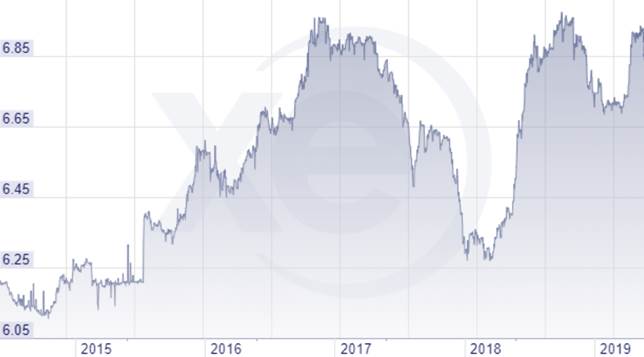
US$ to CNY, www.xe.com
Then in May of this year the yuan suffered a crisis of confidence due to the escalation of the trade war.
US President Trump cried foul over what he deems as unfair currency devaluation saying China can nullify the effects of the billions of tariffs the US has levied against it, by cutting the yuan’s value, something it has done for years.
“We should be entitled to have a fair playing field ... because our Fed is very, very disruptive to us,” Trump told SquawkBox, via CNBC, referring to the central bank’s policy of raising interest rates, thereby keeping the dollar high.
South China Morning Post notes that China’s exchange rate is at the heart of trade negotiations because the US administration has demanded that Beijing agree to limit the yuan’s decline to the extent that it did not fully offset the US tariff increase – a condition that analysts said was acceptable to Beijing to end the trade war.
Meanwhile the euro has appreciated about 20% against the US dollar. That, combined with comments from European Central Bank President Mario Draghi, has put Trump in a foul mood regarding the European Union, even as he agreed to defer for six months a planned US tariff on cars and car parts from the trading block.
Draghi said last week that “in the absence of any improvement”, referring to low growth and low inflation, more stimulus will be needed to goose the European Union’s economy. That could include interest rate cuts or a return to quantitative easing, where the ECB, like the US Federal Reserve, prints dollars to purchase government bonds.
After he signaled two rate cuts this year as the solution, the euro sunk 0.3% against the dollar, prompting Trump to complain on Twitter that a weaker euro made it easier for Europe to compete against the US.
“Mario Draghi just announced more stimulus could come, which immediately dropped the Euro against the Dollar, making it unfairly easier for them to compete against the USA. They have been getting away with this for years, along with China and others,” the president wrote in a tweet.
The irony in Trump’s comments is that the United States is the ultimate currency manipulator, by lowering interest rates and buying trillions worth of government bonds during quantitative easing, between 2008 and 2015, thus pushing down the value of the US dollar.
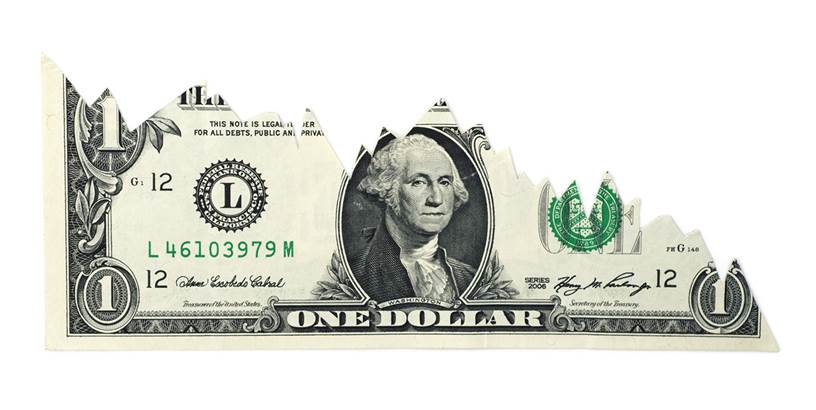
The question is, are we moving from a trade war to a currency war? Trump’s comments about Draghi appear to suggest a hardening of his stance against competitive devaluations. Presumably the same spiral of currency devaluations and tariffs could apply to the China-US trade war, if China decides to purposely devalue the yuan to gain an advantage over the US - say as leverage for getting a trade deal.
But it’s not just China. We are seeing signs of competitive devaluation in other countries, with many loosening their monetary policies as the global growth machine grinds to a halt and economies cool off.
Struggling to deal with too-low inflation, the European Central Bank is promising to hold already rock-bottom interest rates until mid-2020; for the same reason the US Federal Reserve signaled a rate cut is on its way. Reuters points out that reducing interest rates or at least sounding off on the possibilities, is “in vogue at the moment.”
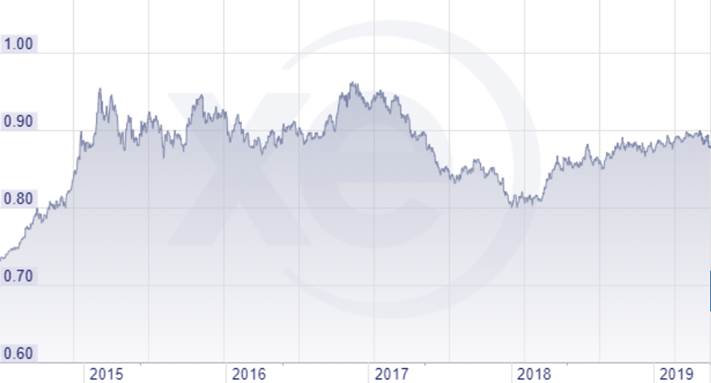
US$ to EUR, www.xe.com
The news service notes that, along with the Fed, the ECB and the Bank of Japan pursuing a dovish monetary policy, so are emerging markets, such as India and Russia which have already started easing. Indonesia, the Philippines and Brazil have flagged interest rate cuts in the near future. Switzerland, Japan, Sweden and Denmark have all gone to negative or near-negative interest rates, to try and spur growth and to stimulate exports.
The fact that the Bank of Indonesia, which has been extremely cautious about easing, has cut banks’ reserve ratio by half a percentage point, and is hinting at cheaper money, shows how dovish the world has gone.
But being dovish doesn’t necessarily mean a currency war, does it? No, but it certainly appears the Trump administration is preparing to go on the offensive.
Recently the Treasury Department came out with a report that recommended nine trading partners should face scrutiny over their currencies - China, Germany, Japan, South Korea, Ireland, Italy, Malaysia, Vietnam and Singapore.
Also notable, the latest report expanded the list of nations under review, from 12 to 21.
Echoing what was said about the 1997 Asian Financial Crisis, at the top, Andrew Moran, writing for Liberty Nation, argues nothing good can come of a race-to-the-bottom round of currency devaluations. Even though cheaper imports would help middle class Americans’ purchasing power, it’s not worth it considering the damage it would due to the international monetary system, Moran writes:
Like a military conflict and a trade war, there aren’t any victors. It can be difficult to determine when central banks fire the first shots, but these bullets are usually pointed at their own heads because a currency war is more like currency suicide. The act of destroying any semblance of value will inevitably harm a nation and its economy in myriad ways, from slashing rates to creating price inflation.
Trump’s low-dollar obsession
The Trump administration wants to keep interest rates and the dollar low. This is a shift from Trump’s predecessors in the White House who have lobbied for a strong dollar.
For Trump, a low dollar is the way to bring jobs back to the US after so many were exported abroad to take advantage of lower labor costs, and therefore rebuild the US manufacturing sector, primarily, through cheaper exports. He’s particularly targeted China for competitively devaluing its currency to dump cheap exports into the US, such as steel and aluminum.
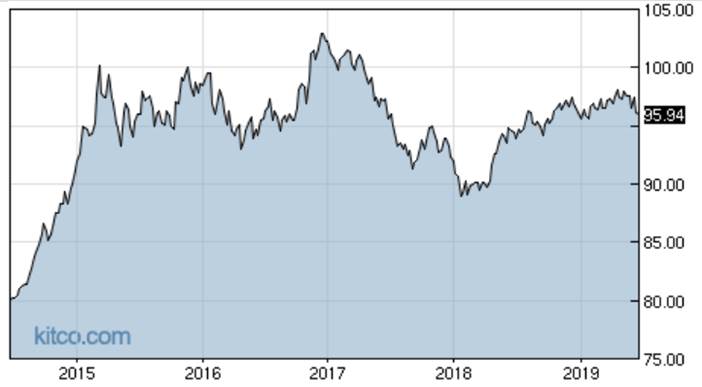
The problem for the United States is that throughout the past several years, the dollar has remained high in relation to other currencies, and that has created a large trade deficit – $825 billion for 2018. As the country with the world’s reserve currency, the United States has to run trade deficits, because the US dollar is far and beyond the most demanded currency in the world. Just about all commodities are priced in US dollars and the USD is the currency in which most international transactions are conducted. A relentlessly high dollar means the US will always run a trade deficit.
It’s a problem though, because a trade deficit means the US imports more than it exports – consumers are buying more goods and services from abroad than locally. Think Walmart. However, US exporters face resistance from foreign buyers because products priced in dollars are more expensive. They want a low dollar.
It is primarily the result of the trade deficit – and especially the trade deficit with China, – that prompted the Trump administration to engage in a series of tit for tat tariffs, now totaling hundreds of billions worth of goods, with its most powerful economic competitor.
Here’s where the problem comes in. If the US deliberately lowers its currency, through interest rate reductions, and injecting billions of dollars into the economy, through bond-buying, even under the guise of fixing its trade deficit, America’s trading partners get miffed. Because the US under Trump is not only going after China, it’s targeting Canada, Mexico and Europe, in threatening or hitting them with tariffs. The only way for them to respond is competitive devaluation.
The ‘stubborn child’
The latest in the Trump versus Fed Chair Jerome Powell clash is an accusation by Trump that the Federal Reserve is behaving like “a stubborn child” in refusing to cut interest rates, in response to other countries’ dovish monetary policies.
His contention is that if only the central bank were to slash interest rates, make the Fed’s objective a weaker dollar, the economy would be stronger.
The problem right now for the Federal Reserve, is it’s not clear whether the economy is booming or busting. Last week’s decision by the Fed to keep interest rates unchanged, while paving the way for a cut in July, sent the S&P 500 to a new record high. At the same time though, US Treasury yields sunk to three-year lows. The former indicates a booming economy while the latter is screaming recession, Zero Hedge writes, in explaining the “alligator jaws” in the graph below:
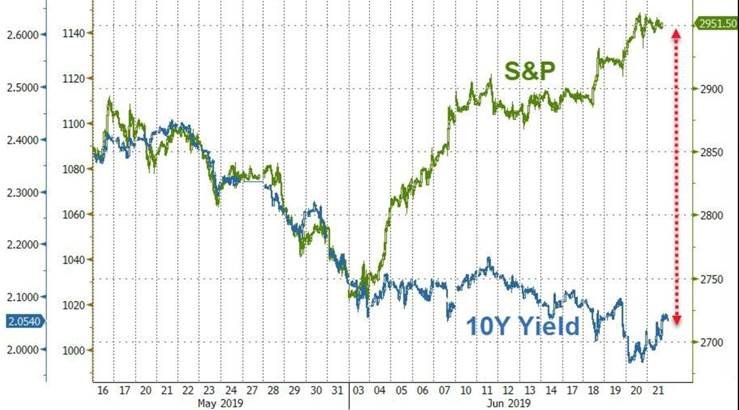
The problem boils down to one simple observation: on one hand stocks are telegraphing substantial market upside and, at least in theory, a booming economy, while bond yields - at 3 year lows - are screaming recession.
We have reached a point where the consequences of the Fed's actions are dire in either case, resulting in either recession or loss of Fed credibility and independence:
In the case of unresponsive Fed it is a recession, while in the case of an accommodative Fed it is the loss of central bank independence and potentially another round of trade wars and even more pressure on the Fed to cut rates with further markets addiction to stimulus and possibly higher inflation etc.
Changing the rules
Back to the currency war, while we’re not yet racing to the bottom, the US Commerce Department has just been appointed new powers that certainly appear to take the fight with China in this direction.
France24 reports on a proposed new rule that allows the United States to impose tariffs on any country it determines is manipulating its currency.
The publication explains that, while previous presidents and lawmakers “have floated plans to go after governments that manipulate their exchange rate to compete in the global trading system,” none have followed through because they were thought to be a violation of global trade rules.
A careful reading of the France24 story reveals a startling fact: under the new rules, the US Commerce Department is being given a wide scope of power to decide whether or not a country is manipulating its currency to the detriment of the United States.
Right now, the US Treasury produces a report every six months on whether any country is manipulating their currency to the disadvantage of the United States. A finding of currency manipulation could lead to trade sanctions - although none has been named since 1994 when the Clinton administration slapped the label on China.
Under the new rules, that power would be given to the Department of Commerce, which “could impose tariffs to offset the weaker exchange rate against the US dollar,” states France24 - the same quid pro quo the US is demanding of China during current trade negotiations. If the EUR has depreciated 20% against the USD, no problem, immediately slap a minimum 20% tariff on imports to the US.
And now for the real kicker:
According to the proposal, Commerce said it would defer to Treasury's evaluation of whether a currency is undervalued, “unless we have good reason to believe otherwise.”
In other words, the list of 21 trading partners that the Treasury Department said should face scrutiny over their currencies are now, or are after June 27th, open to getting tariffs equal to, or likely slightly more, then their currency has been devalued.
Commerce doesn’t have to investigate further. Or at the very least, it’s ambiguous as to what the department has to do. The Treasury’s finding ‘of undervalued’ could conceivably be enough to move forward with trade sanctions.
The plan “would grant the Commerce Department excessive discretion.” Mark Sobel, a former Treasury department officer quoted by France24
The proposal is currently receiving public input but is due to become law by June 27. If it does the Commerce Department has been granted sweeping jurisdiction over exchange rates and implementation of tariffs.
Courting catastrophe
It doesn’t take a whole lot of rumination to conclude where the Trump administration is going with this: Where governments before it were too timid, too much of a team player maybe, to act on powers the Treasury Department has had since the 1980s, in leveling a finding of currency manipulation on a trading partner, Trump has gifted this power to the Commerce Department.
Commerce is a “Cabinet-level agency” of the federal government, which among its duties, negotiates bilateral trade agreements. Note that for 2020, Trump asked for $12.2 billion for the Department of Commerce, a billion dollars more (+9.3%) than was budgeted in 2019.
It is this kind of unilateralism, often born of hubris - one pictures a gun-toting sheriff walking into a saloon looking to bust some heads - that has got the US into trouble before. Trump may mean well in putting America’s interests first, but the difference is that historically, the US has always gone with the carrot and the stick. With Trump, it’s all stick. Here’s Project Syndicate:
Far from displaying a capacity to persuade, as the title of his book The Art of the Deal might imply, Trump is attempting to use raw power alone to force his “America First” agenda on the rest of the world.
“Tariffs,” Trump recently gloated, “are a beautiful thing when you’re the piggy bank, when you have all the money.”
And yet the message of history is clear: by embracing force and eschewing persuasion, the US is undermining its own authority – and courting catastrophe.
Project Syndicate gives the following as examples of how the US drew its pistol first, and asked questions later:
- In 1950 when General Douglas MacArthur, after driving North Korean forces out of the South, heedlessly marched north, where his forces and their allies encountered – and were overrun by – Chinese forces.
- in 1964, when the US used attacks by North Vietnamese torpedo boats on American destroyers in the Gulf of Tonkin as a pretext for adopting a congressional resolution that allowed President Lyndon B. Johnson, and then President Richard M. Nixon, to escalate US military involvement in the Vietnam War. (The parallels with the current situation in the Gulf of Oman are concerning, to say the least.)
- in the 2000s in the course of the War on Terror, which relied on massive force and shunned the strategic cunning favored by many American diplomats, sowing instability throughout an already-fragile Middle East.
It concludes:
For now, the US still has enough power to force countries to bend to its will. But the world is already working to change that. There is a growing push away from dollar-denominated transactions. The European Central Bank is promoting increased use of the euro internationally, while China signs currency-swap agreements to promote the renminbi.
We agree and have made the same argument in previous articles. Indeed, on economic concerns, the United States under Trump seems bound and determined to bully its way into the next financial crisis, blissfully ignoring the economic warning signals while repeating the endlessly cliched, “Make America Great Again”.
Columnist Stephen Roach eviscerates the administration for its frequent policy blunders and lack of historical knowledge - particularly of America’s disastrous dalliance with protectionism:
Ignoring the cascading stream of direct and retaliatory taxes on consumers and businesses that stem from a tariff war, Trump extols the virtues of tariffs as “a beautiful thing.” That is painfully reminiscent of the 1928 Republican Party platform, which couched tariffs as “a fundamental and essential principle of the economic life of this nation … and essential for the continued prosperity of the country.” Trump ignores the lessons of the 1930s at great peril...
Trump’s vindictive bluster has steamrolled economic-policy deliberations – ignoring the lessons of history, rejecting the analytics of modern economics, and undermining the institutional integrity of the policymaking process. Policy blunders of epic proportion have become the rule, not the exception. It won’t be nearly as easy to spin the looming consequences.
Conclusion
The United States came awfully close to attacking Iran a few days ago. Thankfully Trump saw sense in standing down after being told 150 Iranians would die. Sensibly, the commander in chief decided 150 dead wasn’t proportionate to shooting down an un-manned drone. No kidding.
Now talk has shifted to the possibility, if not of a shooting war, of a currency war. In these fragile times, when the yield curve is inverted and flashing red for recession, when the economy is so weak that prices aren’t even growing 2%, when investors are mindlessly piling into stocks like Pavlov’s dogs and are happily locking into 10-year bonds with .22% real yields, we have a problem, Houston.
The last thing we need is for the White House to devalue the dollar trying to out-export China, the greatest exporting nation of all time, while taking on Europe, and its sickly euro, in a second currency war front. We saw what happened in Asia in 1997: hyper-inflation, mass unemployment, living standards flushed down the toilet of debt, the IMF eventually having to bail them out.
Everyone dissed Trump for imposing tariffs for reasons of “national security” but the president has blocked that channel of criticism by imbuing the Department of Commerce with the power to slap tariffs on currency manipulators. I think we can all believe that order will come directly from Trump himself.
Just another way that Trump is doing an end-run around conventional politics in Washington to get things done his way. Unfortunately for American’s their dollar just took another hard kick to it’s ‘Exorbitant Privilege.’
By Richard (Rick) Mills
If you're interested in learning more about the junior resource and bio-med sectors please come and visit us at www.aheadoftheherd.com
Site membership is free. No credit card or personal information is asked for.
Richard is host of Aheadoftheherd.com and invests in the junior resource sector.
His articles have been published on over 400 websites, including: Wall Street Journal, Market Oracle, USAToday, National Post, Stockhouse, Lewrockwell, Pinnacledigest, Uranium Miner, Beforeitsnews, SeekingAlpha, MontrealGazette, Casey Research, 24hgold, Vancouver Sun, CBSnews, SilverBearCafe, Infomine, Huffington Post, Mineweb, 321Gold, Kitco, Gold-Eagle, The Gold/Energy Reports, Calgary Herald, Resource Investor, Mining.com, Forbes, FNArena, Uraniumseek, Financial Sense, Goldseek, Dallasnews, Vantagewire, Resourceclips and the Association of Mining Analysts.
Copyright © 2019 Richard (Rick) Mills - All Rights Reserved
Legal Notice / Disclaimer: This document is not and should not be construed as an offer to sell or the solicitation of an offer to purchase or subscribe for any investment. Richard Mills has based this document on information obtained from sources he believes to be reliable but which has not been independently verified; Richard Mills makes no guarantee, representation or warranty and accepts no responsibility or liability as to its accuracy or completeness. Expressions of opinion are those of Richard Mills only and are subject to change without notice. Richard Mills assumes no warranty, liability or guarantee for the current relevance, correctness or completeness of any information provided within this Report and will not be held liable for the consequence of reliance upon any opinion or statement contained herein or any omission. Furthermore, I, Richard Mills, assume no liability for any direct or indirect loss or damage or, in particular, for lost profit, which you may incur as a result of the use and existence of the information provided within this Report.
© 2005-2022 http://www.MarketOracle.co.uk - The Market Oracle is a FREE Daily Financial Markets Analysis & Forecasting online publication.



